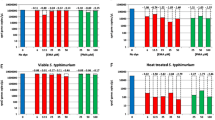Abstract
The research was aimed to evaluate the effectiveness of genetic markers when assessing the vitality of mycobacteria after room disinfection as a disinfection quality parameter. To achieve this goal, the mycobacterial genome was analyzed, and genetic markers identifying mycobacteria and marker mycobacterial products with the shortest lifetime after a mycobacterial cell dies were sought for. A room where animals were experimentally infected with mycobacteria was examined. Mycobacterium and the Mycobacterium tuberculosis complex DNA markers can be detected in one tube in CY5 and R6G channels. To differentiate Mycobacterium bovis BCG and the Mycobacterium tuberculosis complex, DNA deletion was detected using ROX- and R6G-labeled PCR probes. The comparison of genetic identification and mycobacterial vitality evaluation results with those of bacteriological tests completely confirm the effectiveness of genetic detection of mycobacterial viability. This approach to evaluate the disinfection quality makes it possible to avoid false-positive (using classic PCR) and false-negative (using bacteriologic culturing) results when controlling the tuberculosis causative agents.



Similar content being viewed by others
References
Agustí, G., Fittipaldi, M., & Codony, F. (2017). False-positive viability PCR results: an association with microtubes. Current Microbiology, 74(3), 377–380. https://doi.org/10.1007/s00284-016-1189-3.
Aleksandrova, N. M., Faizov, T. K., Vasileva, A. V., Rogozhina, I. A., Khammadov, N. I., & Shuralev, E. A. (2018). Indication and identification of Bacillus anthracis isolates from the Middle Volga Region by multi-primer PCR. BioNanoScience., 8(1), 434–440. https://doi.org/10.1007/s12668-017-0477-0.
Behr, M. A. (2013). Evolution of Mycobacterium tuberculosis. Advances in Experimental Medicine and Biology, 783, 81–91. https://doi.org/10.1007/978-1-4614-6111-1_4.
Brites, D., & Gagneux, S. (2017). The nature and evolution of genomic diversity in the Mycobacterium tuberculosis complex. Advances in Experimental Medicine and Biology, 1019, 1–26. https://doi.org/10.1007/978-3-319-64371-7_1.
Choo, S. W., Dutta, A., Wong, G. J., Wee, W. Y., Ang, M. Y., & Siow, C. C. (2016). Comparative genomic analysis reveals a possible novel non-tuberculous Mycobacterium species with high pathogenic potential. PLoS One, 11(4), e0150413. https://doi.org/10.1371/journal.pone.0150413.
Davis, G. L., Ray, N. A., Lahiri, R., Gillis, T. P., Krahenbuhl, J. L., Williams, D. L., & Adams, L. B. (2013). Molecular assays for determining Mycobacterium leprae viability in tissues of experimentally infected mice. PLoS Neglected Tropical Diseases, 7(8), e2404. https://doi.org/10.1371/journal.pntd.0002404.
Della Bella, C., Spinicci, M., Grassi, A., Bartalesi, F., Benagiano, M., Truthmann, K., Tapinassi, S., Troilo, A., D’Elios, S., Alnwaisri, H., Shuralev, E., Singh, M., Bartoloni, A., & D’Elios, M. M. (2018). Novel M. tuberculosis specific IL-2 ELISpot assay discriminates adult patients with active or latent tuberculosis. PLoS One, 13(6), e0197825. https://doi.org/10.1371/journal.pone.0197825.
Dinh Thanh, M., Agustí, G., Mader, A., Appel, B., & Codony, F. (2017). Improved sample treatment protocol for accurate detection of live Salmonella spp. in food samples by viability PCR. PLoS One, 12(12), e0189302. https://doi.org/10.1371/journal.pone.0189302.
Janssen, K. J., Hoebe, C. J., Dukers-Muijrers, N. H., Eppings, L., Lucchesi, M., & Wolffs, P. F. (2016). Viability-PCR shows that NAAT detects a high proportion of DNA from non-viable Chlamydia trachomatis. PLoS One, 11(11), e0165920. https://doi.org/10.1371/journal.pone.0165920.
Jou, N. T., Yoshimori, R. B., Mason, G. R., Louie, J. S., & Liebling, M. R. (1997). Single-tube, nested, reverse transcriptase PCR for detection of viable Mycobacterium tuberculosis. Journal of Clinical Microbiology, 35(5), 1161–1165.
Khaertynov, K. S., Valeeva, A. R., Ivanov, A. V., Mukminov, M. N., Urazov, N. G., Khaertynova, I. M., Aleksandrova, N. M., Moskvicheva, A. V., Efimova, M. A., Akhmadeev, R. M., Samigullina, E. S., Nabatov, A. A., & Shuralev, E. A. (2018). Extraction and serological properties of Mycobacterium cell surface and excreted proteins. BioNanoScience., 8(1), 459–466. https://doi.org/10.1007/s1266.
Khammadova, A. V., Shuralev, E. A., Khammadov, N. I., Oumarou, B. M., Faizov, T. K., & Mukminov, M. N. (2017). Design of primers for identification of honey bee viruses in multiplex-PCR. Astra Salvensis., 5(Suppl. 1), 481–489.
Khammadova, A. V., Khammadov, N. I., Kosarev, M. A., Osyanin, K. A., & Shuralev, E. A. (2018). Investigating nano particles in bioinformatic analysis of the brucella genome for indication and differentation by qPCR. International Journal of Engineering and Technology (UAE), 7(4.7), 227–230.
Kralik, P., Babak, V., & Dziedzinska, R. (2014). Repeated cycles of chemical and physical disinfection and their influence on Mycobacterium avium subsp. paratuberculosis viability measured by propidiummonoazide F57 quantitative real time PCR. Veterinary Journal, 201(3), 359–364. https://doi.org/10.1016/j.tvjl.2014.05.032.
Mahairas, G. G., Sabo, P. J., Hickey, M. J., Singh, D. C., & Stover, C. K. (1996). Molecular analysis of genetic differences between Mycobacterium bovis BCG and virulent M. bovis. Journal of Bacteriology., 178(5), 1274–1282.
Slavchev, G., Michailova, L., & Markova, N. (2013). Stress-induced L-forms of Mycobacterium bovis: a challenge to survivability. The New Microbiologica, 36(2), 157–166.
Vasilyeva, E., Abdulkhakov, S., Cherepnev, G., Martynova, E., Mayanskaya, I., Valeeva, A., Abdulkhakov, R., Safina, D., Khaiboullina, S., & Rizvanov, A. (2016). Serum cytokine profiles in children with Crohn’s disease. Mediators of Inflammation, 2016, 7420127. https://doi.org/10.1155/2016/7420127.
Acknowledgements
This study was supported by the Russian Government Program of Competitive Growth of Kazan Federal University.
Author information
Authors and Affiliations
Corresponding author
Ethics declarations
Conflict of Interest
The authors declare no conflict of interest
Research Involving Humans and Animals Statement
No animals were used in this study.
Funding Statement
This research received no specific grant from any funding agency in the public, commercial, or non-for-profit sectors.
Additional information
Publisher’s Note
Springer Nature remains neutral with regard to jurisdictional claims in published maps and institutional affiliations.
Rights and permissions
About this article
Cite this article
Khammadov, N.I., Aleksandrova, N.M., Khammadova, A.V. et al. Evaluation of the Effectiveness of Genetic Markers of Mycobacteria for Assessing the Disinfection Quality by Viability Real Time PCR. BioNanoSci. 9, 918–927 (2019). https://doi.org/10.1007/s12668-019-00654-8
Published:
Issue Date:
DOI: https://doi.org/10.1007/s12668-019-00654-8




